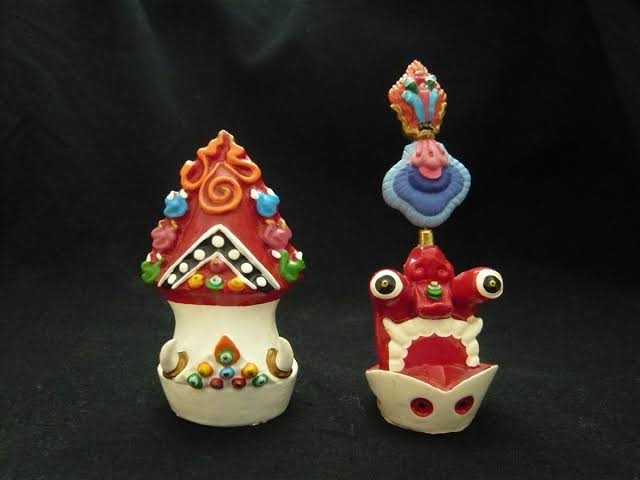Page 1 of 1
what Torma tradition?
Posted: Sun Aug 11, 2019 12:03 pm
by Aldo white

which position to use in shirine room?
Left to right
1° watter ?
2° watter ?
3 ° flower torma ? 5 senses
4° incense
5° no use butterlamp?
6° perfum watter
7° other torma?
8° no sound offering?
Anyone know how to inform?
is this correct form? to assign torma home altar whartful
Re: what Torma tradition?
Posted: Sun Aug 11, 2019 5:45 pm
by Grigoris
The teacher I follow says that wrathful offerings should be done in the opposite direction: You start with music and work towards the right to washing water.
Re: what Torma tradition?
Posted: Mon Aug 12, 2019 3:12 am
by conebeckham
Those are Kagyu tormas......Karma Kagyu, Tsurphu Tradition.
You have a "Wangpo Metok" or Flower of the Senses, and a "Drakpo Shelze," or wrathful Food offering.
Normally, offerings to deities in front, in other words on the shrine, go from your left to your right, starting with the two waters, then flowers, incense, light, scented water, food, and music.
For Wrathful offerings, say to protectors or wrathful yidams, the Wangpo Metok takes the place of the flower, and the DrakShel is the food offering.
Sometimes, the offerings go in the opposite direction, depending on which deity or practice you are engaged in. Sometimes, there are offerings "missing"--say, Argham but no PAydam (Drinking water but not washing water), and sometimes there are additional "waters" or other offerings.
Re: what Torma tradition?
Posted: Mon Aug 12, 2019 3:13 am
by conebeckham
Actually, on closer inspection, they may be Karma Kagyu tormas of the Palpung tradition...it's hard to say for sure. The base of the Shelze is fairly thick, and the torma is "stocky." Those are typical characteristics of Palpung tradition.
Re: what Torma tradition?
Posted: Mon Aug 12, 2019 7:27 am
by Grigoris
conebeckham wrote: ↑Mon Aug 12, 2019 3:12 amSometimes, there are offerings "missing"--say, Argham but no PAydam (Drinking water but not washing water)...
I have noticed that in some sadhana. Is it possible for you to explain why?
Thanks Cone!
Re: what Torma tradition?
Posted: Mon Aug 12, 2019 7:14 pm
by conebeckham
Grigoris wrote: ↑Mon Aug 12, 2019 7:27 am
conebeckham wrote: ↑Mon Aug 12, 2019 3:12 amSometimes, there are offerings "missing"--say, Argham but no PAydam (Drinking water but not washing water)...
I have noticed that in some sadhana. Is it possible for you to explain why?
Thanks Cone!
Short answer: It's tradition.
Longer answer: depends on the practice......just as an example, and I don't think this contravenes samaya, Phagmo is not offered "paydam" or "washing/rinsing water for the feet."Perhaps her feet are not dirty?

Re: what Torma tradition?
Posted: Mon Aug 12, 2019 11:25 pm
by Aldo white
found these photos seems to be offering mahakala and haiagriva.
Can anyone who knows a nigyma master talk about using for vajrakilaya?
Re: what Torma tradition?
Posted: Tue Aug 13, 2019 11:18 am
by Bristollad
Kalarupa is another deity who isn't offered padyam - the explanation I was given was offering water to clean his feet would be in some way seeking to negate his trampling of enemies.
Re: what Torma tradition?
Posted: Tue Aug 20, 2019 12:55 am
by Fortyeightvows
Bristollad wrote: ↑Tue Aug 13, 2019 11:18 am
Kalarupa is another deity who isn't offered padyam - the explanation I was given was offering water to clean his feet would be in some way seeking to negate his trampling of enemies.
Thank you for that!
Re: what Torma tradition?
Posted: Sat Jan 25, 2020 5:07 pm
by AmidaB
conebeckham wrote: ↑Mon Aug 12, 2019 7:14 pm
Grigoris wrote: ↑Mon Aug 12, 2019 7:27 am
conebeckham wrote: ↑Mon Aug 12, 2019 3:12 amSometimes, there are offerings "missing"--say, Argham but no PAydam (Drinking water but not washing water)...
I have noticed that in some sadhana. Is it possible for you to explain why?
Thanks Cone!
Short answer: It's tradition.
Longer answer: depends on the practice......just as an example, and I don't think this contravenes samaya, Phagmo is not offered "paydam" or "washing/rinsing water for the feet."Perhaps her feet are not dirty?

Hi,
I have heard that there is no 'water'for the feet when the given protector/deity never stops in her/his activity. No time for feet washing. As you surely know the whole process is mimicking the ancient indian tradition. When you would like to wash the feet of your precious guest, he or she have to take a seat at first.
Re: what Torma tradition?
Posted: Sat Feb 29, 2020 9:30 am
by tingdzin
For the Nyingma Putri Regphung phurpa, 16 offerings are ideally arranged along a single line, starting from your left with the usual 2 peaceful waters, flower,etc. but in the middle, where the wrathful offerings start, it's wrathful food,etc, so that the last two on your right are the two wrathful "waters". Don't have a picture, but I hope that's clear.
Aldo white wrote: ↑Mon Aug 12, 2019 11:25 pm
Can anyone who knows a nigyma master talk about using for vajrakilaya?
"waters"